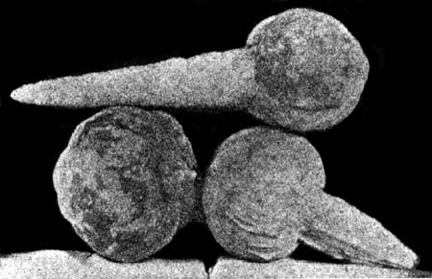MOUNT SIGNAL CONCRETIONS
by Eva May Hyde
Some twenty-five years ago while living in Calexico, Imperial Valley, California, a group of us decided to climb Mt. Signal, which is fourteen miles to the west. This is the only "mountain" in Imperial Valley and rises to the height of 2262 feet, but when one considers the Valley is below sea level, it really is a mountain to those who live there. We did not climb Mt. Signal for we found at the northern base some very interesting objects of sandstone, which some of us had heard about. They were so numerous that we thought little of their scientific value.
The old timers thought these resembled organic forms like the giant kelp, Macrocystis pyrifera, and when we recalled that the northern end of Mt. Signal is on the old sea beach it gave this idea some weight.
Upon inquiry from some of the residents of that region we found this explanation. "Each one is formed by a hole being made by a crab or other marine animal and as the water poured in the hole the sand was set in motion. As it went round and round the center solidified and the length of the handle was according to the depth of the hole."
Other more recent explanations are to the effect that they are petrified plant life of higher type, presumable mushrooms. In fact, an advanced student in mycology in the botanical department at the University of California some years ago made a trip to Imperial Valley, to collect specimens and photographs of these "petrified mushrooms."
About the only studies available on this matter are those made by S.C. Edwards in "Rocks and Minerals," June 1934; Dr. H. W. Nichols in Field Columbian Museum, "Publication 111"; and Kenneth B. Garner in "American Journal of Science," April 1936, which are to effect that these are concretions.
At the present time scientists are not willing to make definite statements as to how they were formed. All agree that calcite is the aggregating material in the sand, which solidifies producing these forms. The well-known sandspikes from South Dakota and the Barite roses from Pitcher, Oklahoma are formed by the same process as our concretions.
Originally published in:
THE MINERALOGIST
JANUARY, 1937. All rights reserved.
